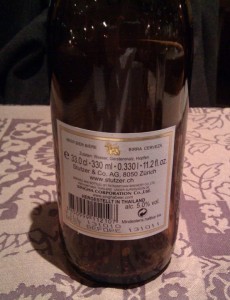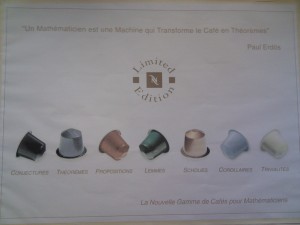Back when I was preparing my book on the large sieve, around 2007 (the almost famous one), one question I struggled with was to find an upper bound for the largest dimension — say  — of an irreducible complex representation of a finite group of Lie type
— of an irreducible complex representation of a finite group of Lie type  , such as as
, such as as  or
or  (in fact, especially the latter, since the first application I had in mind involved this group, the symplectic similitudes over a finite field.) Here, in my mind, the main variable was the size of the finite field, and not the parameter
(in fact, especially the latter, since the first application I had in mind involved this group, the symplectic similitudes over a finite field.) Here, in my mind, the main variable was the size of the finite field, and not the parameter  or
or  (i.e., not the rank of the underlying group of Lie type).
(i.e., not the rank of the underlying group of Lie type).
I was pretty much convinced that this must be a well-known question with an easy answer (it the sense that anything that is known is “easy”, at least if one only needs to cite it to use it…) However, despite much Google search and even more Mathscinet search, I didn’t find this. I ended up asking an expert on the theory of finite groups of Lie type, who also had no reference in mind, but who could sketch how the bound I was expecting should follow from the theory of Deligne-Lusztig of (generalized) characters of finite groups of Lie type. This bound is of the type

for a (connected) semisimple group  of dimension
of dimension  and rank
and rank  , when
, when  grows. The underlying heuristic is quite simple: among the representations of
grows. The underlying heuristic is quite simple: among the representations of  , there are the “principal series”, parametrized by the characters of a maximal torus, and there are about
, there are the “principal series”, parametrized by the characters of a maximal torus, and there are about  of them, each of the same dimension
of them, each of the same dimension  . But on the other hand one knows that
. But on the other hand one knows that

(a basic fact of representation theory of finite groups), so we get something like

(the last equivalence is quite easy in concrete cases, and natural from general principles about the number of solutions of equations over finite fields), and if one believes that  should be equal or close to the maximum, the guess above follows.
should be equal or close to the maximum, the guess above follows.
Incidentally, I think I already knew that a reverse inequality

is always true (in the generality above) because there is an explicit representation of that dimension, the Steinberg representation.
“At any rate”, I succeeded in getting a proof of a bound of the type

with an (explicit) implied constant depending only on the rank  , learning the basic language of Deligne-Lusztig characters in doing so. (In fact, for
, learning the basic language of Deligne-Lusztig characters in doing so. (In fact, for  or
or  with
with  large enough with respect to
large enough with respect to  or
or  , one gets an exact formula which immediately implies this.)
, one gets an exact formula which immediately implies this.)
Now a few weeks ago, I saw a preprint of Larsen, Malle and Tiep appear on arXiv. The title The largest irreducible representations of simple groups is this time explicit enough, and the paper contains beautiful results, targeted towards the case of large rank in the case of groups of Lie type, because… the case of large  was treated in a paper of G. M. Seitz in 1989!
was treated in a paper of G. M. Seitz in 1989!
However, the title of the latter paper is Cross-characteristic embeddings of finite groups of Lie type; the relevant section 2 is entitled An upper bound for the degrees of irreducible modules in this paper; and finally the Math Review (by R.W. Carter), although it does mention this section as being of independent interest, states
Then if  is an absolutely irreducible
is an absolutely irreducible  -module of arbitrary characteristic we have
-module of arbitrary characteristic we have  , where
, where  is a maximal torus of
is a maximal torus of  of minimal order
of minimal order
This is perfectly limpid, but note that it fails to mention any of the keywords upper bound, maximal dimension or representation that I had been using in my frantic searches before…
I don’t know what is the moral of the story here. Knowing about this paper of Seitz (e.g., by asking around more systematically, or asking online, etc) would have saved me a fair amount of time, indeed. But then I wouldn’t have looked further into the theory of Deligne-Lusztig characters, which is very beautiful. To understand this theory, I also wouldn’t have had to look more deeply, and more concretely, into the structure theory of finite groups of Lie type and of algebraic groups in general. I would therefore know much less today, even though I would have known much earlier (and in greater generality!) this exact statement… But if I had known about Seitz’s work earlier, I would have been able to properly acknowledge this priority, of course — which I am of course happy to do here (whether there will be another printing of my book to update it is far from clear…)
In other words, beware which questions you ask: sometimes the worst thing that could happen is to get a precise answer…
Here’s a last remark: Seitz’s proof is somewhat like the one I had constructed, and relies on Deligne-Lusztig characters, and further work of Lusztig (I avoided some of the refinements of the latter by sticking with groups with connected centers which, for reasons amusingly related with the Langlands duality of reductive groups, are the “good” groups of Lie type for such arguments…) As Seitz observes, it would be interesting to have an elementary proof of these facts.
(End note: it is well-known that the corresponding question about lower bounds on the smallest dimension of a non-trivial representation of a finite group is of considerable importance in many applications of harmonic analysis on finite groups; for the simplest case of  , the lower bound is
, the lower bound is  , and this can be proved elementarily, as O. Dinai recalled me and others during last Friday’s train ride from Lausanne…)
, and this can be proved elementarily, as O. Dinai recalled me and others during last Friday’s train ride from Lausanne…)
(Update, 4.2.2011: I have updated, on my page of minor writings, the note containing the self-contained extract of my book with its proof of the upper-bound to mention Seitz’s priori result.)

